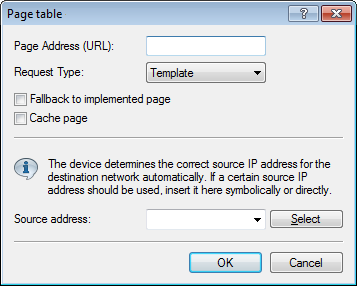A custom template page allows you to replace the internal LCOS template pages with your own Web pages. This does not overwrite the LCOS templates, but just exchanges them for your own pages. If need be, you can fallback to the standard pages.
The steps below use the example of a Login page to show you how to set up a custom template page with the help of LANconfig.
-
You can load your customized error page either onto an external HTTP(S)-server or as the Public Spot - Login page (* .html, * .htm) into the memory of the device.
Further information about uploading your own templates and sample files are available on the Internet in the LANCOM Support Knowledgebase under Implementing your own websites for the LANCOM Public Spot option.
-
Open the device configuration dialog in LANconfig, navigate to the Public Spot > Server dialog and select Page table > Login.

- Enter the URL of the login page on the external server under Page address (URL) or the reference for a file on the local device (file://pbspot_template_login).
-
You can make these additional settings if necessary.
- Request type: If you are using an external server, you can change the way in which the page is called. By default (in the setting Template) the device loads an externally stored HTM(L) page from the specified URL for further processing by the internal HTTP server. If you change the setting to Redirect, the device outsources the processing of the pages to the external server (also see User-defined pages via HTTP redirect).
- Fallback to implemented page: If you use an external server and chose the template type Request, the Public Spot module is able to use the internal LCOS template in case of HTTP(S) errors (e.g. if the server is unavailable). This enables the Public Spot to continue operating (also see Auto fallback). If you do not activate this setting, the Public Spot displays the fallback error page instead.
- Cache page: On some devices, you can write local and external templates to a cache. Learn more about under Template caching.
- Source address: This setting allows you to specify the loopback address used by the device to connect to the external HTTP(S) server. By default, the server sends its replies back to the IP address of your device without having to enter it here. By entering an optional loopback address you change the source address and route used by the device to connect to the server. This can be useful, for example, when the server is available over different paths and it should use a specific path for its reply message.
- Close this dialog and also the general configuration dialog each with click on OK. LANconfig then writes the new settings back to the device.
That's it!
